Abstract
In this paper the results of the EMC tests of the wideband power sources: the PWM-based power source and audio power amplifier are discussed. They are intended to be used to supply the measuring system developed for evaluation of the wideband transformation accuracy of instrument transformers. Therefore, it is required to detect possible interferences that may be caused by the power supply to its operation and that may cause a decrease in its accuracy. The tests concern the conducted emission in the frequencies range from 150 kHz to 30 MHz and the radiated emission in the frequencies range from 30 MHz to 1 GHz. Moreover, the level of conducted disturbances in frequencies range from 100 Hz to 5 kHz generated into the supplying current is measured and the immunity of both wideband power sources to low frequency conductive disturbances in the supplying voltage and current is tested. Then, the voltage gain error and phase shift of the output voltage are measured. The EMC tests of both power sources show lack of compliance with the requirement of the standard IEC 61326-1. However, in system application of the audio power amplifier is possible if required increased immunity to conducted emission of the measuring system is ensured.
1. Introduction
Wideband power sources are required in many applications, but one of the most demanding of them is supplying the measuring systems designed for testing of the inductive instrument transformers [1,2,3,4,5,6,7,8,9,10,11,12,13,14]. This is due to the fact that all the electromagnetic compatibility (EMC) requirements must not interfere with the operation of the sensitive measuring system, and simultaneously a high output power is required. This results from the nonlinearity of the magnetization characteristics of the magnetic core of the inductive instrument transformers, and the necessity to be tested in their rated operating conditions [12,13]. Therefore, during testing of wideband accuracy of voltage instrument transformers and dividers increases the exposure to the magnetic field from high voltage [1,2,3,4,5,6,7,8]. Additionally, the supplying of the measuring system used for testing current instrument transformers requires high immunity to the magnetic field from the high current track [6,7,8,9,10,11,12,13,14]. Wideband testing procedures of transformation accuracy of inductive instrument transformers at harmonics of distorted current or voltage and requirements for the measuring and supplying systems are still under development [5,8,9,10,14,15]. The demand for such tests results from the low power quality of current and voltage in the power networks [1,11]. According to EU directive 2014/30/EU the electrical equipment should meet the requirements of electromagnetic compatibility [16]. It ensures that electrical and electronic equipment does not generate, or is not affected by, electromagnetic disturbance. The wideband power sources are subject to the standard IEC 61326-1 that covers specify requirements for immunity and emission including the limits of radiated and conductive disturbances for electrical equipment, operating from the circuit being measured [17]. In the field of conducted and radiated emission of disturbances power sources are subject to the standard EN 55011, which complies with general requirements of the standard IEC 61000-6-4 for emission in industrial environments [18,19].
In the paper [20], the development of a programmable three phase AC power source is presented. It is capable of providing a stable voltage with variable amplitude and variable frequency over a wide range. Moreover, it can generate low harmonic distortion arbitrary waveforms. In the paper [21], the response for the need for calibrators of different electrical equipment to generate non-sinusoidal voltages and currents is presented. Voltage harmonics magnitude and phase angle closed control loops enable accurate and precise adjustment of waveform parameters. The aim of this work is the development of a wideband power supply specified for laboratory testing with distorted current and voltage where the level and phase of each higher harmonics are individually selectable. One tested power source is self-made from audio power amplifier and arbitrary waveform generator and its behavior is compared with an off-the-shelf source type Chroma 61504. The application of the power source is to supply the step-up current or voltage transformer to test the wideband transformation accuracy of inductive instrument transformers [9,11,12,13,14,15]. The results of the EMC test of the audio power amplifier are compared with the results obtained for the off-the-shelf source. Moreover, the different modes of operation tested to find the worst condition concern the different loads and also the output frequency of the source. Furthermore, the voltage gain error and phase shift between input and output of tested power source at different frequencies are measured to determine if the input waveform composed of many harmonics is accurately reproduced.
2. Objects of the Research
The EMC tests were performed on two wideband power sources. Device A is a PWM-based power source model Chroma 61504 and device B is an audio power amplifier. The PWM-based power source has four main elements: input stage with active power factor correction, DC rail, PWM control circuit and output-stage inverter. The power factor correction is provided the control of the current of the inductor and output capacitor by the MOSFET drive in order to ensure that input current and the AC line voltage are in phase with each other. A PWM-controlled inverter is formed by two transistors, each one is used for the lower or upper part of the waveform generated as a series of various-width rectangles [15,22]. The rated power of the tested PWM-based power source is equal to 2 kVA. A total of two voltage ranges are available: 0 to 150 and 0 to 300 V, with the maximum rms values of the output current equal to 16 or 8 A, respectively. Its frequency band of operation with the rated apparent power is equal to 1 kHz.
The tested audio power amplifier is a linear amplifier of class H with the output stage transistors operating in class AB. They are working in the push-pull topology. The crossover distortion is reduced as each transistor is conducting for more than half of the period. The H class amplifiers are more power efficient as they are designed to draw power from the higher voltage rail only when the output voltage is higher than in the low voltage rail. It has two channels that can either work separately or bridged to double the output voltage. Common control of gain will automatically track each channel identically and the input voltage of the first channel will be amplified in the counter-phase by each channel. The rated output power is equal to 2 kW and is available into 2 Ω rated output resistance per channel or 4 kW into 4 Ω in the bridge mode. The rms output voltage is equal to 70 V for each channel separately or 140 V bridged. The rated rms value of the output currents is equal to 28 A. The application of a linear amplifier to provide a wideband power source requires an arbitral waveform generator to control the input signal. The wideband power source composed of the audio power amplifier with an arbitrary generator enables for a ¼ of the price twice higher active output power than the PWM-based power source. The main advantage of the off-the-shelf source is its ability for autonomous operation. However, its frequency band of operation with its rated output power is only 1 kHz. Moreover, during operation with high inductive impedance the output voltage of the audio power amplifier is limited by 2 [15]. It is a typical load when the step-up current and AC test transformers are supplied [1,2,3,4,8,9,13,14].
3. Conducted and Radiated Emission Tests
The tests in the field of electromagnetic compatibility concern measurements of the conducted emission according to the IEC 61326-1 standard in the frequencies range from 150 kHz to 30 MHz and the tests of radiated emission in the frequencies range from 30 MHz to 1 GHz [16]. The conducted disturbance emission was tested with the use of the SMR 4503 measuring receiver, the LISN artificial network NNB-51 and a computer with COMPLIANCE-3 software version 3.90 (Figure 1a). The emission of radiated disturbances was tested with the use of the GTEM-1000 chamber, the SMR 4503 measuring receiver and a computer with COMPLIANCE-3 software version 3.90 (Figure 1b).
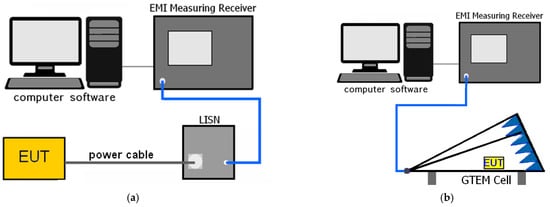
Figure 1.
Measuring systems for: (a) conducted emission tests; (b) radiated emission tests.
In the case of both power sources the tests were carried out to detect the influence of the frequency of generated output voltage on the conducted emission. Measurements were made for two selected frequencies: 50 and 1000 Hz. Additionally, the influence of the output power of the device on conducted emissions was examined. Measurements were made for three selected power levels: 1500, 770, 440 W. The results of the measurement are shown in Figure 2, Figure 3, Figure 4 and Figure 5. In Figure 2 the frequency spectrum of conducted emission of PWM-based power source (device A) is presented. The frequencies of generated voltage by the device under test are equal to 50 and 1000 Hz with the value of the active load power equal to 1500 W.
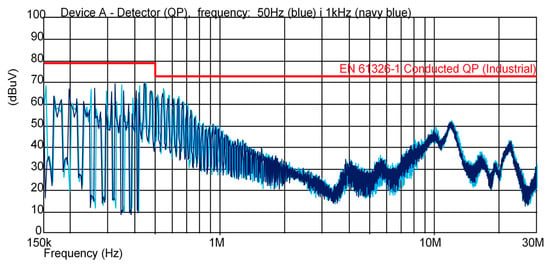
Figure 2.
Frequency spectrum of conducted emission of the PWM-based power source (device A) for frequencies of generated voltage by the device under test equal to 50 and 1000 Hz.
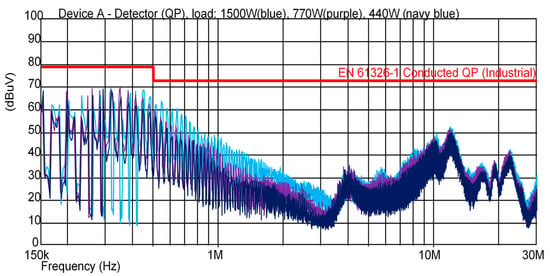
Figure 3.
Frequency spectrum of conducted emission of the PWM-based power source (device A) for frequency of generated voltage by the device under test equal to 50 Hz and the values of the active load power equal to 1500, 770, and 440 W.
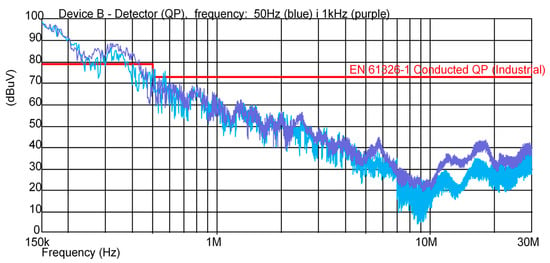
Figure 4.
Frequency spectrum of conducted emission of the audio power amplifier (device B) for frequencies of generated voltage by the device under test equal to 50 and 1000 Hz.
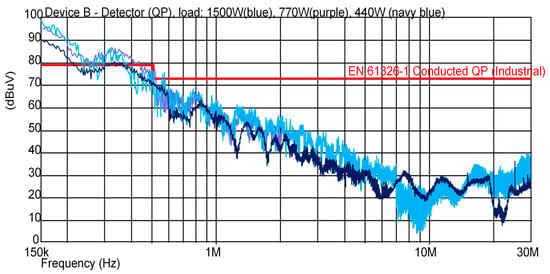
Figure 5.
Frequency spectrum of conducted emission of the audio power amplifier (device B) measured for frequency of generated voltage by the device under test equal to 50 Hz and the values of the active load power equal to 1500, 770, and 440 W.
The limiting values for conducted emission resulting from the standard IEC 61326-1 for the electrical equipment operating from the circuit being measured were not exceeded. Moreover, for device A, no influence of the generated frequency on the level of disturbances was observed.
In Figure 3 the frequency spectrum of conducted emission of PWM-based power source (device A) is presented. The frequencies of generated voltage by the device under test are equal to 50 Hz and the values of the active load power are equal to 1500, 770, and 440 W.
A decrease in the value of the output power causes a slight reduction in the level of generated conducted disturbances in the range from 400 kHz to 3 MHz by the PWM based power source.
In Figure 4, the frequency spectrum of conducted emission of the audio power amplifier (device B) is presented. The frequencies of the generated output voltage by the device under test are equal to 50 and 1000 Hz with output load active power equal to 1500 W.
For device B, no influence of the frequency of generated output voltage on the level of disturbances was observed, except for the range of 10–20 MHz. The limit specified for the level of conducted disturbances in the IEC 61326-1 standard was exceeded by the audio power amplifier. It is due to the fact that the device is not equipped by the manufacturer with an appropriate EMI (electromagnetic interference) filter.
In Figure 5, the frequency spectrum of conducted emission of the audio power amplifier (device B) is presented. The frequency of generated voltage by the device under test is equal to 50 Hz and the values of the active load power are equal to 1500, 770, and 440 W.
When the output power of device B is reduced, a decrease in the level of disturbances in the range of frequencies from 150 kHz to 30 MHz is observed, except for the range from 7 to 14 MHz.
In the case of conducted emission tests no significant influence of frequency of generated output voltage on the disturbance spectrum of both devices was observed. The results concerning the influence of the value of the output power confirm that it is an important factor in the assessment of the electromagnetic compatibility of the power sources with the requirements of the standard IEC 61326-1. Conducted disturbance emission measurements should be performed at the rated output power for which the device is designed to operate.
The radiated emission was tested for two selected frequencies of the output voltage equal to 50 and 1000 Hz with three levels of the output power: 1500, 770, and 440 W. The measurement results are shown in Figure 6, Figure 7, Figure 8 and Figure 9. In Figure 6, the frequency spectrum of radiated emission of PWM-based power source (device A) is presented. The frequencies of the generated output voltage by the device under test are equal to 50 and 1000 Hz with the values of the active load power equal to 1500 W.
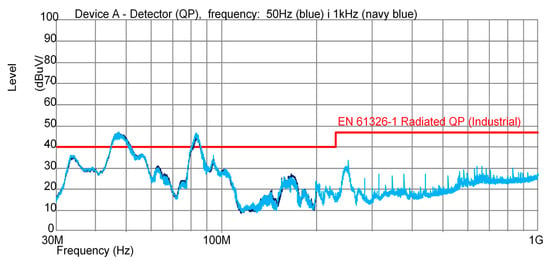
Figure 6.
Frequency spectrum of radiated emission of PWM-based power source (device A) for frequencies of generated voltage by the device under test equal to 50 and 1000 Hz.
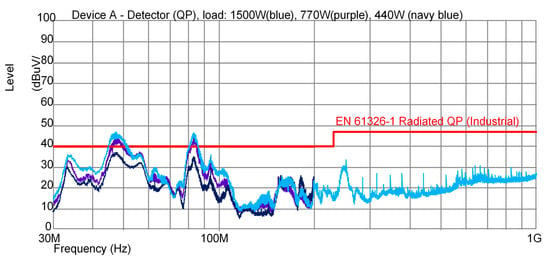
Figure 7.
Frequency spectrum of radiated emission of PWM-based power source for frequency of generated voltage equal to 50 Hz and the values of the active load power equal to 1500, 770, and 440 W.
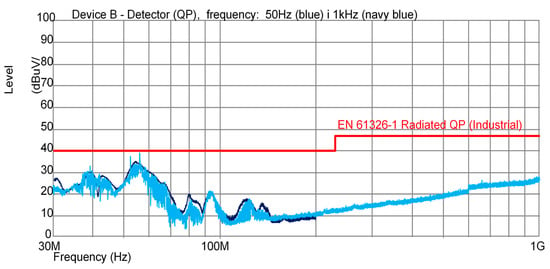
Figure 8.
Frequency spectrum of radiated emission of audio power amplifier (device B) for frequencies of generated voltage by the device under test equal to 50 and 1000 Hz.
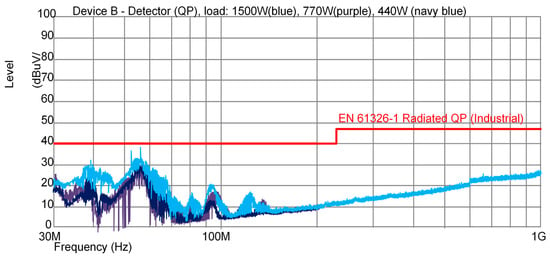
Figure 9.
Frequency spectrum of radiated emission of audio power amplifier (device B) for frequency of generated voltage equal to 50 Hz and the values of the active load power equal to 1500, 770, and 440 W.
There is no detected influence of the frequency of generated output voltage on the level of radiated disturbances. The limit specified for the level of conducted disturbances in the IEC 61326-1 standard was exceeded by the PWM-based power source. The probable cause of the problem is the PWM-controlled inverter. To reduce the radiated emissions ferrite cores can be used.
In Figure 7, the frequency spectrum of radiated emission of PWM-based power source (device A) is presented. The frequency of generated voltage by the device under test is equal to 50 Hz and the values of the active load power are equal to 1500, 770, and 440 W.
In the case when the value of the output power of the PWM-based power source is reduced a significant decrease in the level of radiated disturbances is detected.
In Figure 8, the frequency spectrum of radiated emission of an audio power amplifier (device B) is presented. The frequencies of generated voltage by the device under test are equal to 50 and 1000 Hz with active load power equal to 1500 W.
The limiting values for radiated emission resulting from the standard IEC 61326-1 for the electrical equipment operating from the circuit being measured were not exceeded. Moreover, for device B, no influence of the frequency of generated voltage on the level of disturbances is observed.
In Figure 9, the frequency spectrum of conducted emission of an audio power amplifier (device B) is presented. The frequency of generated output voltage by the device under test is equal to 50 Hz and the values of the active load power are equal to 1500, 770, and 440 W.
Along with a decrease in the output power a significant decrease in the level of radiated disturbances is detected.
The results of the measurements of radiated emissions show as well high importance of the value of the output power of tested power source on the detected level of radiated disturbances. Therefore, the tests of compliance of the power source with the requirements of the standard IEC 61326-1 should be performed with the rated output power for which the device is designed.
4. Conducted Disturbances Tests in Frequencies Range from 100 Hz to 5 kHz
The next stage of laboratory tests aims to determine the level of conducted disturbances produced by two tested power sources in the frequency range from 100 Hz to 5 kHz. The measurements were made for inductive and resistive loads and different rms values of output current. The measuring circuit used to determine the rms values of harmonics in supplying current is presented in Figure 10.
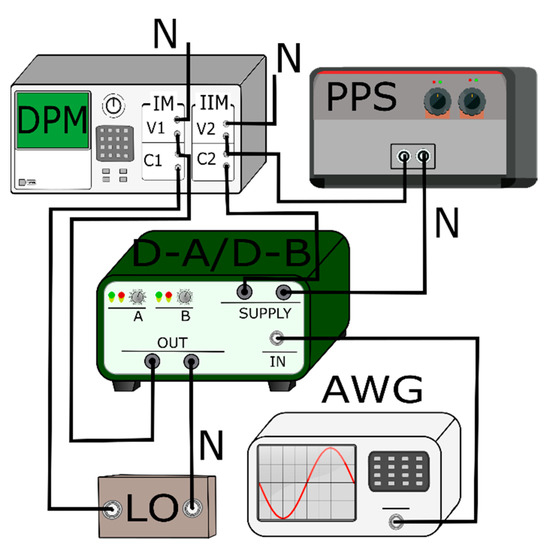
Figure 10.
Measuring circuit used to determine the rms values of harmonics in supplying current of wideband power sources.
In Figure 10, the following notations are used: AWG—arbitrary waveform generator, DPM—digital power meter, D-A/D-B—device A (PWM-based power source) or device B (audio power amplifier), PPS—programmable power supply, LO—load impedance of tested devices.
Utilization of the programmable power source ensures the pure sinusoidal voltage of frequency equal to 50 Hz to supply tested devices. To determine the total harmonic distortion factors (THDi) of suppling current one module of the digital power meter (DPM) is used to measure the rms values of harmonics of current and voltage. Moreover, the second module is used to measure output power to ensure the required load. In accordance with the standard IEC 50160 THDi factor may be calculated from formula [23]:
In Table 1 calculated values of THDi factors for supply currents of tested PWM-based power source and audio power amplifier are presented. The percentage values of a given higher harmonics are presented in Figure 11.

Table 1.
The values of THDi factors of supply currents of tested PWM-based power source and audio power amplifier.
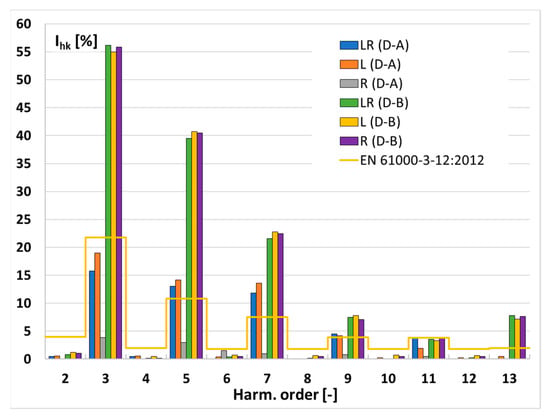
Figure 11.
Percentage values of a given higher harmonics in suppling current of the PWM-based power source (D-A) and audio power amplifier (D-B).
The PWM-based power source has a much lower distortion of the supply current in comparison with the audio power amplifier as results of determined values of total harmonics distortion factor. This results from the application of the power factor correction system that controls the time of charging of the output capacitor of DC rail through the inductor [15]. The highest value of the THDi factor was detected in the case of the PWM-based power source for the rms value of the output current equal to 1 A. The lowest value is obtained for the maximum rms value of the output current equal to 6.5 A. There are no detected changes in obtained values due to the type of the load. The results for the audio power amplifier as well show no influence of the power factor but significant dependence on the load value, therefore the rms value of the output current.
The audio power amplifier is characterized by a supply current consisting of higher harmonics which rms values are significantly exceeding the limiting values specified in the standard EN 61000-3-12 [24]. This results from a distortion of the waveform of supply current presented in Figure 12b. It will increase the exposure of the measuring systems connected to the same AC mains. Parts 3–16, covering limits for harmonic currents produced by energy supplying equipment with a rated current less than or equal to 75 A per phase connected to public low-voltage systems, is still not available. The differences in the percentage values of the higher harmonics generated into the supplying current of the PWM-based power source result from the rms value of the output current. If the rms value of the output current is equal to 6.5 A, the rms values of suppling current is the highest, therefore the percentage values of higher harmonics are the lowest (Figure 11). In case when its rms value drops to 2.5 A for both resistive and inductive loads the rms values of harmonics of the input current are equal but significantly increased. In Figure 12 the waveforms of the output and input currents and voltages measured for the PWM-based power source and the audio power amplifier for these conditions are presented.

Figure 12.
Waveforms of input and output voltages and current of tested. (a) PWM-based power source and (b) audio power amplifier (yellow—supply voltage, green—supply current, red—output voltage, blue—output current).
The waveform of the suppling current of the audio power amplifier (Figure 12b) is similar to a typical rectifier. The principle of operation of the power factor correction system in the PWM-based power source ensures significantly lower distortion of the suppling current. Moreover, its waveform is the same for inductive and resistance load, however the rms values of output current and voltages are different [25].
5. Gain, Phase Linearity, and Conducted Disturbances Immunity Tests
The next stage of laboratory tests of the power sources was to determine the linearity of their voltage gain and phase shift with frequency in the range from 50 Hz to 5 kHz for sinusoidal and distorted input voltage. These tests were carried out in the measuring circuit presented in Figure 13.
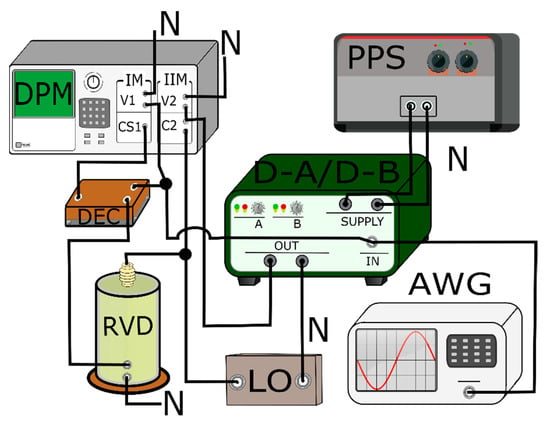
Figure 13.
Measuring circuit used to determine the values of voltage gain error and phase shift.
In Figure 13 the notations are used as in Figure 10, additionally: RVD—wideband reference voltage divider, DEC—wideband converter of differential voltage to single ended voltage.
The tested devices (D-A/D-B) are supplied by the programmable power source (PPS) fed by the arbitrary waveform generator (AWG) which enables to generate any supply voltage waveform required for the conducted disturbances immunity tests. The wideband reference voltage divider (RVD) is used to step-down the output voltage of the tested power source. The voltage ratio of the used RVD is selected in order to obtain the required gain for a given test conditions [2,4,26]. The measuring system is composed of a digital power meter (DPM), in which the second module is used to measure the rms values of harmonics (up to 100th) of output voltage and current, as well as the phase shift between them. Moreover, the value and power factor of the load is determined. To obtain the values of voltage gain error and phase shift of harmonics caused by the tested device first module of DPM is used to measure the rms values of harmonics of input voltage and the rms values of harmonics of differential voltage between the output voltage of RVD and the input voltage of tested power source. Application of the high impedance wideband converter of differential voltage to single ended voltage (DEC) is required in ordered to prevent the impact of measuring circuit on the output voltage of used RVD [6,14]. The rms values of the hk harmonic of the output voltage of the tested device is determined from the equation:
UINhk—the rms values of a k-order harmonic of the input voltage of tested power source, UOUThk—the rms values of a k-order harmonic of the output voltage of tested power source, UDEChk—the rms values of a k-order harmonic of the output voltage of the DEC which is equal to difference voltage between the output voltage of RVD and the input voltage of tested power source, φRVDDEChk—the phase shift of a k-order harmonic of the output voltage of DEC in relation to the same frequency harmonic in the input voltage of tested power source.
The value of the voltage gain error of hk harmonic of the output voltage may be calculated from equation:
The percentage value of the hk harmonic of the composite error resulting from its voltage gain error and additional phase sift in the output voltage is determined from equation:
Determined hk values of the composite error and voltage gain errors are used to calculate the value of the additional phase shift of harmonic of the output voltage:
Gain and phase linearity test with the frequency of the input voltage during amplification of sinusoidal of frequency equal to 50 or 500 Hz, and distorted input voltages were performed when tested devices were supplied by the programmable power source. The percentage values of higher harmonics were equal to the required values by the relevant standard [19]. Tests were performed in the no-load state and when the output active power was equal to 1500, 770, and 440 W or apparent power was equal to 1500, 770, and 440 VA with power factor equal to 0.45 were performed. The measurement results are presented in Figure 14.
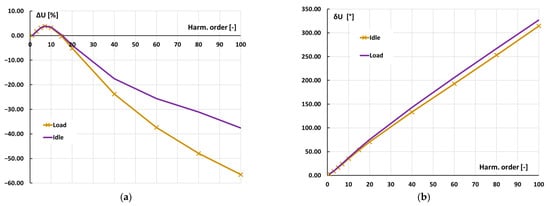
Figure 14.
Voltage gain errors (a) and phase shift (b) with the frequency of the input voltage.
In the case of the PWM-based power source the most significant impact on the value of the voltage gain error and phase shift has the frequency of the input voltage. In the no-load state the voltage gain errors (Figure 14a) have lower values than in the load state (from 20th harmonic). This may result from increased additional voltage drop on internal elements of the device for increased output current. The same values of voltage gain errors and phase shift were obtained regardless of the value of the load power factor. Furthermore, even for the case when conducted disturbances occur in the supply of PWM-based power source, the frequency characteristics of voltage gain errors and phase shift are the same as in Figure 14.
The frequency characteristic of voltage gain errors and phase shift for audio power amplifier is presented in Figure 15.

Figure 15.
Voltage gain errors (a) and phase shift (b) with the frequency of the input voltage.
In the case of the audio power amplifier the most significant impact on the value of the voltage ratio error has the frequency of the input voltage but it is negligible taking into comparison the results determined for the PWM-based power source. This phenomenon is caused by the input low pass filter that is selected at too high a frequency. Moreover, there are slight changes in the power factor and value of the load of the power amplifier ±0.5%. Furthermore, even for the case when conducted disturbances occur in its supply voltage and current the frequency characteristics of voltage gain errors and phase shift are the same as in Figure 15. The immunity to low frequency conductive disturbances results from the conversion of the power by DC rail.
6. Conclusions
The EMC tests of both power sources show the lack of compliance with the requirement of the standard IEC 61326-1. In the case of the tested PWM-based power source the problem concerned exceeded limits of the radiated emissions, while in the audio power amplifier the level of conducted emissions was too high. In the case of conducted disturbances in the frequencies range from 100 Hz to 5 kHz generated into the supplying current by the PWM-based power source their level results from the rms value of supply current. This is caused by the pulsed operation of the rectifier in the PWM-based power source and it is significantly lower than in the case of the audio power amplifier. This is ensured by the application of the power factor correction system that controls the time of charging of the output capacitor of DC rail through the inductor. The immunity of both wideband power sources to low frequency conductive disturbances in the supply voltage and current results from the conversion of the input power by DC rail. In the case of the PWM-based power source the most significant impact on the value of the voltage gain error and phase shift has the frequency of the input voltage. Therefore, the feedback loop used by the manufacturer for the control of the rms values of harmonics of the output voltage is required. The results of the research clearly show that the EMC tests of the wideband power sources intended to be used for supplying the measuring systems are essential for their proper operation.
Author Contributions
Conceptualization, D.B., E.S.; methodology, D.B., E.S.; software, D.B., E.S. and M.A., validation, D.B., E.S.; formal analysis, D.B., E.S.; investigation, D.B.; E.S.; M.A., and P.K. resources, D.B., E.S., M.A., and P.K.; data curation, D.B., E.S., and M.A.; writing—original draft preparation, D.B., E.S., and M.A.; writing—review and editing, D.B., E.S.; visualization, D.B., E.S., M.A., and P.K.; supervision, D.B., E.S. All authors have read and agreed to the published version of the manuscript.
Funding
This research received no external funding.
Institutional Review Board Statement
Not applicable.
Informed Consent Statement
Not applicable.
Data Availability Statement
The data presented in this study are available on request from the corresponding author. Computer data is not publicly available because it is not suitable for use by another researcher.
Conflicts of Interest
The authors declare no conflict of interest.
References
- Filipović-Grčić, D.; Filipović-Grčić, B.; Krajtner, D. Frequency response and harmonic distortion testing of inductive voltage transformer used for power quality measurements. Procedia Eng. 2017, 202, 159–167. [Google Scholar] [CrossRef]
- Kaczmarek, M. The effect of distorted input voltage harmonics rms values on the frequency characteristics of ratio error and phase displacement of a wideband voltage divider. Electr. Power Syst. Res. 2019, 167, 1–8. [Google Scholar] [CrossRef]
- Klatt, M.; Meyer, J.; Elst, M.; Schegner, P. Frequency Responses of MV voltage transformers in the range of 50 Hz to 10 kHz. In Proceedings of the 14th International Conference on Harmonics and Quality of Power-ICHQP, Bergamo, Italy, 26–29 September 2010; pp. 1–6. [Google Scholar] [CrossRef]
- Kaczmarek, M.; Szatilo, T. Reference voltage divider designed to operate with oscilloscope to enable determination of ratio error and phase displacement frequency characteristics of MV voltage transformers. Meas. J. Int. Meas. Confed. 2015, 68, 22–31. [Google Scholar] [CrossRef]
- Faifer, M.; Ottoboni, R.; Toscani, S.; Cherbaucich, C.; Mazza, P. Metrological Characterization of a Signal Generator for the Testing of Medium-Voltage Measurement Transducers. IEEE Trans. Instrum. Meas. 2014, 64, 1. [Google Scholar] [CrossRef]
- Kaczmarek, M. Development and application of the differential voltage to single-ended voltage converter to determine the composite error of voltage transformers and dividers for transformation of sinusoidal and distorted voltages. Meas. J. Int. Meas. Confed. 2017, 101, 53–61. [Google Scholar] [CrossRef]
- Cataliotti, A.; Cosentino, V.; Crotti, G.; Giordano, D.; Modarres, M.; Di Cara, D.; Tine, G.; Gallo, D.; Landi, C.; Luiso, M. Metrological performances of voltage and current instrument transformers in harmonics measurements. In Proceedings of the 2018 IEEE International Instrumentation and Measurement Technology Conference (I2MTC), Houston, TX, USA, 14–17 May 2018; pp. 1–6. [Google Scholar] [CrossRef]
- Mingotti, A.; Bartolomei, L.; Peretto, L.; Tinarelli, R. On the Long-Period Accuracy Behavior of Inductive and Low-Power Instrument Transformers. Sensors 2020, 20, 5810. [Google Scholar] [CrossRef] [PubMed]
- Kaczmarek, M.L.; Stano, E. Application of the inductive high current testing transformer for supplying of the measuring circuit with distorted current. IET Electr. Power Appl. 2019, 13, 1310–1317. [Google Scholar] [CrossRef]
- Cristaldi, L.; Faifer, M.; Laurano, C.; Ottoboni, R.; Toscani, S.; Zanoni, M. A Low-Cost Generator for Testing and Calibrating Current Transformers. IEEE Trans. Instrum. Meas. 2018, 68, 2792–2799. [Google Scholar] [CrossRef]
- Kaczmarek, M. Inductive current transformer accuracy of transformation for the PQ measurements. Electr. Power Syst. Res. 2017, 150, 169–176. [Google Scholar] [CrossRef]
- Kaczmarek, M. Wide Frequency Operation of the Inductive Current Transformer with Ni80Fe20 Toroidal Core. Electr. Power Components Syst. 2014, 42, 1087–1094. [Google Scholar] [CrossRef]
- Kaczmarek, M. Estimation of the inductive current transformer derating for operation with distorted currents. Bull. Pol. Acad. Sci. Tech. Sci. 2014, 62, 363–366. [Google Scholar] [CrossRef][Green Version]
- Kaczmarek, M.; Stano, E. Proposal for extension of routine tests of the inductive current transformers to evaluation of transformation accuracy of higher harmonics. Int. J. Electr. Power Energy Syst. 2019, 113, 842–849. [Google Scholar] [CrossRef]
- Kaczmarek, M.; Kaczmarek, P. Comparison of the Wideband Power Sources Used to Supply Step-Up Current Transformers for Generation of Distorted Currents. Energies 2020, 13, 1849. [Google Scholar] [CrossRef]
- Directive 2014/30/EU of the European Parliament and of the Council of 26 February 2014 on the harmonisation of the laws of the Member States relating to electromagnetic compatibility, European Parliament and the Council of the European Union. 2014. Available online: https://eur-lex.europa.eu/legal-content/EN/TXT/?uri=celex%3A32014L0030 (accessed on 1 September 2020).
- IEC 61326-1. Electrical Equipment for Measurement, Control and Laboratory Use-EMC Requirements-Part 1: General Requirements; International Electrotechnical Commission: Geneva, Switzerland, 2013. [Google Scholar]
- EN 55011. Industrial, Scientific and Medical (ISM) Radio-Frequency Equipment–Electromagnetic Disturbance Characteristics–Limits and Methods of Measurement; International Electrotechnical Commission: Geneva, Switzerland, 2016. [Google Scholar]
- IEC 61000-6-4. Electromagnetic Compatibility (EMC) Part 6-4: Generic Standards–Emission Standard for Industrial Environments; International Electrotechnical Commission: Geneva, Switzerland, 2018. [Google Scholar]
- Vincenzi, F.R.S.; Silva, L.; De Freitas, L.C.G.; Freitas, M.A.A.; Fernandes, E.R.; Vieira, J.B.; Freitas, L.C. Programmable AC power source used to analyze electronic equipment performance in the electrical power system quality concept. In Proceedings of the 2008 Twenty-Third Annual IEEE Applied Power Electronics Conference and Exposition, Austin, TX, USA, 24–28 February 2008; pp. 1931–1937. [Google Scholar] [CrossRef]
- Petrovic, G.; Bosnic, J.A.; Majic, G.; Despalatovic, M. A Design of PWM Controlled Calibrator of Non-Sinusoidal Voltage Waveforms. Energies 2019, 12, 1966. [Google Scholar] [CrossRef]
- Abraham, I.P.; Billings, K.; Taylor, M. Switching Power Supply Design, 3rd ed.; McGraw-Hill Education: New York, NY, USA, 2009; ISBN 9780071482721. [Google Scholar]
- EN 50160. Voltage Characteristics of Electricity Supplied by Public Electricity Networks; CENELEC: Brussels, Belgium, 2010. [Google Scholar]
- IEC 61000-3-12. Electromagnetic Compatibility (EMC)–Part 3-12: Limits–Limits for Harmonic Currents Produced by Equipment connected to Public Low-Voltage Systems with Input Current >16 A and ≤ 75 A per Phase; International Electrotechnical Commission: Geneva, Switzerland, 2011. [Google Scholar]
- Kaczmarek, P. Badania emisji zaburzeń przewodzonych przez programowalne źródło napięcia zmiennego. Przegląd Elektrotechniczny 2019, 1, 35–38. [Google Scholar] [CrossRef]
- IEC 61869-11. Instrument Transformers—Part. 11: Additional Requirements for Low Power Passive Voltage Transformers; International Electrotechnical Commission: Geneva, Switzerland, 2017. [Google Scholar]
Publisher’s Note: MDPI stays neutral with regard to jurisdictional claims in published maps and institutional affiliations. |
© 2021 by the authors. Licensee MDPI, Basel, Switzerland. This article is an open access article distributed under the terms and conditions of the Creative Commons Attribution (CC BY) license (http://creativecommons.org/licenses/by/4.0/).